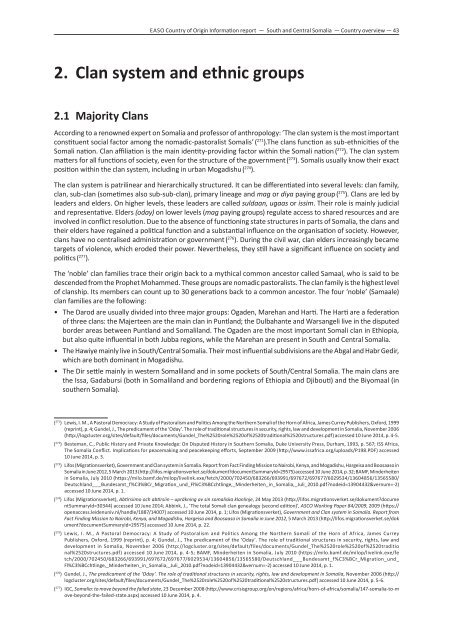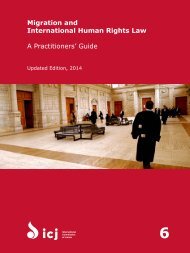Create successful ePaper yourself
Turn your PDF publications into a flip-book with our unique Google optimized e-Paper software.
EASO Country of Origin Information report — South and Central <strong>Somalia</strong> — Country overview — 43<br />
2. Clan system and ethnic groups<br />
2.1 Majority Clans<br />
According to a renowned expert on <strong>Somalia</strong> and professor of anthropology: ’The clan system is the most important<br />
constituent social factor among the nomadic‐pastoralist Somalis’ ( 271 ).The clans function as sub‐ethnicities of the<br />
Somali nation. Clan affiliation is the main identity‐providing factor within the Somali nation ( 272 ). The clan system<br />
matters for all functions of society, even for the structure of the government ( 273 ). Somalis usually know their exact<br />
position within the clan system, including in urban Mogadishu ( 274 ).<br />
The clan system is patrilinear and hierarchically structured. It can be differentiated into several levels: clan family,<br />
clan, sub‐clan (sometimes also sub‐sub‐clan), primary lineage and mag or diya paying group ( 275 ). Clans are led by<br />
leaders and elders. On higher levels, these leaders are called suldaan, ugaas or issim. Their role is mainly judicial<br />
and representative. Elders (oday) on lower levels (mag paying groups) regulate access to shared resources and are<br />
involved in conflict resolution. Due to the absence of functioning state structures in parts of <strong>Somalia</strong>, the clans and<br />
their elders have regained a political function and a substantial influence on the organisation of society. However,<br />
clans have no centralised administration or government ( 276 ). During the civil war, clan elders increasingly became<br />
targets of violence, which eroded their power. Nevertheless, they still have a significant influence on society and<br />
politics ( 277 ).<br />
The ‘noble’ clan families trace their origin back to a mythical common ancestor called Samaal, who is said to be<br />
descended from the Prophet Mohammed. These groups are nomadic pastoralists. The clan family is the highest level<br />
of clanship. Its members can count up to 30 generations back to a common ancestor. The four ‘noble’ (Samaale)<br />
clan families are the following:<br />
• The Darod are usually divided into three major groups: Ogaden, Marehan and Harti. The Harti are a federation<br />
of three clans: the Majerteen are the main clan in Puntland; the Dulbahante and Warsangeli live in the disputed<br />
border areas between Puntland and Somaliland. The Ogaden are the most important Somali clan in Ethiopia,<br />
but also quite influential in both Jubba regions, while the Marehan are present in South and Central <strong>Somalia</strong>.<br />
• The Hawiye mainly live in South/Central <strong>Somalia</strong>. Their most influential subdivisions are the Abgal and Habr Gedir,<br />
which are both dominant in Mogadishu.<br />
• The Dir settle mainly in western Somaliland and in some pockets of South/Central <strong>Somalia</strong>. The main clans are<br />
the Issa, Gadabursi (both in Somaliland and bordering regions of Ethiopia and Djibouti) and the Biyomaal (in<br />
southern <strong>Somalia</strong>).<br />
( 271 ) Lewis, I. M., A Pastoral Democracy: A Study of Pastoralism and Politics Among the Northern Somali of the Horn of Africa, James Currey Publishers, Oxford, 1999<br />
(reprint), p. 4; Gundel, J., The predicament of the ‘Oday’. The role of traditional structures in security, rights, law and development in <strong>Somalia</strong>, November 2006<br />
(http://logcluster.org/sites/default/files/documents/Gundel_The%2520role%2520of%2520traditional%2520structures.pdf) accessed 10 June 2014, p. 4-5.<br />
( 272 ) Besteman, C., Public History and Private Knowledge: On Disputed History in Southern <strong>Somalia</strong>, Duke University Press, Durham, 1993, p. 567; ISS Africa,<br />
The <strong>Somalia</strong> Conflict. Implications for peacemaking and peacekeeping efforts, September 2009 (http://www.issafrica.org/uploads/P198.PDF) accessed<br />
10 June 2014, p. 3.<br />
( 273 ) Lifos (Migrationsverket), Government and Clan system in <strong>Somalia</strong>. <strong>Report</strong> from Fact Finding Mission to Nairobi, Kenya, and Mogadishu, Hargeisa and Boosaaso in<br />
<strong>Somalia</strong> in June 2012, 5 March 2013 (http://lifos.migrationsverket.se/dokumentdocumentSummaryId=29575) accessed 10 June 2014, p. 32; BAMF, Minderheiten<br />
in <strong>Somalia</strong>, July 2010 (https://milo.bamf.de/milop/livelink.exe/fetch/2000/702450/683266/693991/697672/697677/6029534/13604856/13565580/<br />
Deutschland___Bundesamt_f%C3%BCr_Migration_und_Fl%C3%BCchtlinge,_Minderheiten_in_<strong>Somalia</strong>,_Juli_2010.pdfnodeid=13904432&vernum=-2)<br />
accessed 10 June 2014, p. 1.<br />
( 274 ) Lifos (Migrationsverket), Abtirsiimo och abtirsiin – upräkning av sin somaliska klanlinje, 24 May 2013 (http://lifos.migrationsverket.se/dokumentdocume<br />
ntSummaryId=30344) accessed 10 June 2014; Abbink, J., ‘The total Somali clan genealogy (second edition)’, ASCO Working Paper 84/2009, 2009 (https://<br />
openaccess.leidenuniv.nl/handle/1887/14007) accessed 10 June 2014, p. 1; Lifos (Migrationsverket), Government and Clan system in <strong>Somalia</strong>. <strong>Report</strong> from<br />
Fact Finding Mission to Nairobi, Kenya, and Mogadishu, Hargeisa and Boosaaso in <strong>Somalia</strong> in June 2012, 5 March 2013 (http://lifos.migrationsverket.se/dok<br />
umentdocumentSummaryId=29575) accessed 10 June 2014, p. 22.<br />
( 275 ) Lewis, I. M., A Pastoral Democracy: A Study of Pastoralism and Politics Among the Northern Somali of the Horn of Africa, James Currey<br />
Publishers, Oxford, 1999 (reprint), p. 4; Gundel, J., The predicament of the ‘Oday’. The role of traditional structures in security, rights, law and<br />
development in <strong>Somalia</strong>, November 2006 (http://logcluster.org/sites/default/files/documents/Gundel_The%2520role%2520of%2520traditio<br />
nal%2520structures.pdf) accessed 10 June 2014, p. 4-5; BAMF, Minderheiten in <strong>Somalia</strong>, July 2010 (https://milo.bamf.de/milop/livelink.exe/fe<br />
tch/2000/702450/683266/693991/697672/697677/6029534/13604856/13565580/Deutschland___Bundesamt_f%C3%BCr_Migration_und_<br />
Fl%C3%BCchtlinge,_Minderheiten_in_<strong>Somalia</strong>,_Juli_2010.pdfnodeid=13904432&vernum=-2) accessed 10 June 2014, p. 1.<br />
( 276 ) Gundel, J., The predicament of the ‘Oday’. The role of traditional structures in security, rights, law and development in <strong>Somalia</strong>, November 2006 (http://<br />
logcluster.org/sites/default/files/documents/Gundel_The%2520role%2520of%2520traditional%2520structures.pdf) accessed 10 June 2014, p. 5-6.<br />
( 277 ) IGC, <strong>Somalia</strong>: to move beyond the failed state, 23 December 2008 (http://www.crisisgroup.org/en/regions/africa/horn‐of‐africa/somalia/147-somalia‐to‐m<br />
ove‐beyond‐the‐failed‐state.aspx) accessed 10 June 2014, p. 4.



